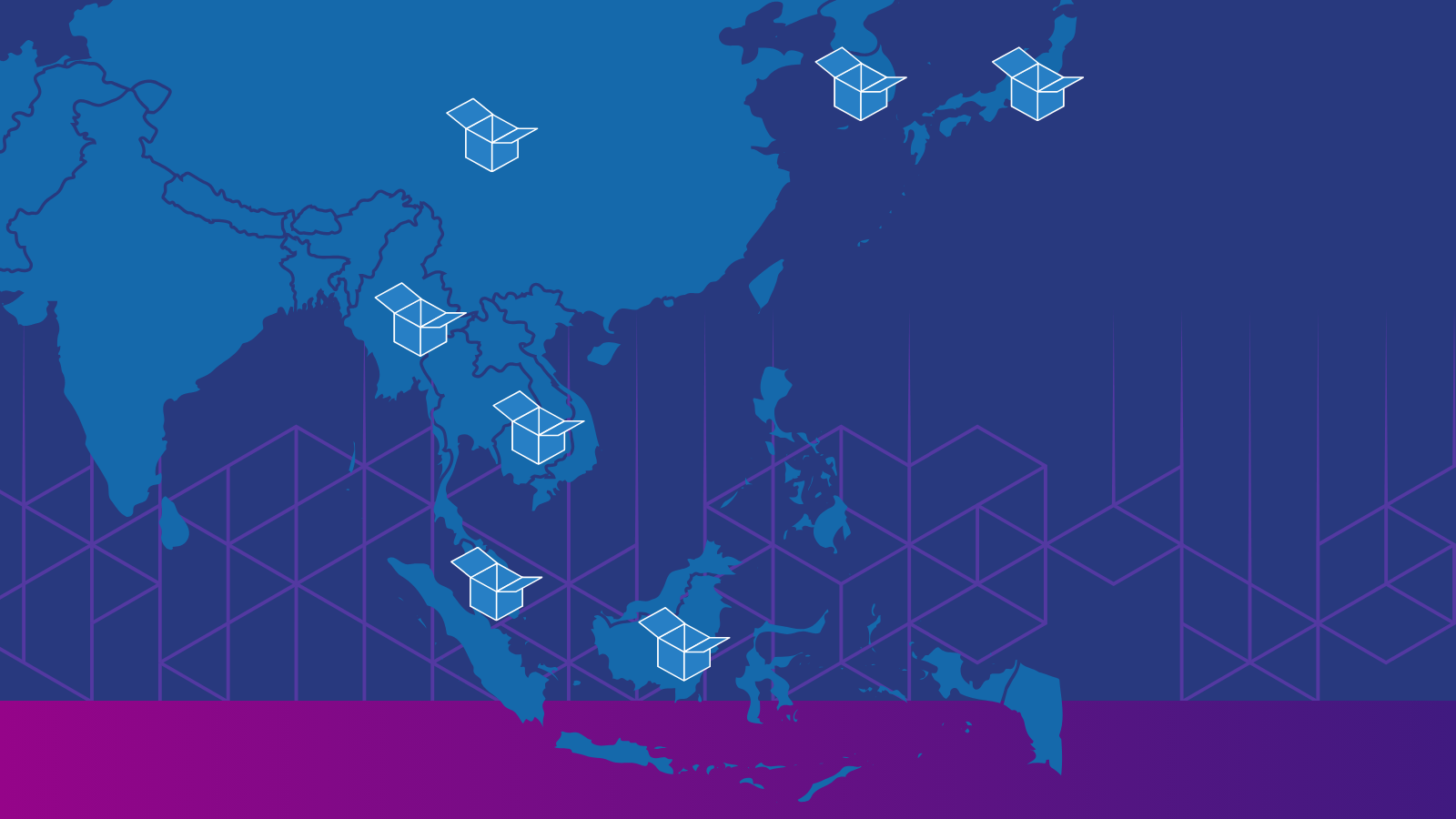As an agile approach and tool, sandboxes enable new technologies to be tested in controlled environments before releasing to the broader market, serving as vital tools for fostering innovation while managing associated risks. While sandboxes are gaining increasing attention globally, their application and impact in Asia remain understudied, despite the region’s significant role in global digital governance and technological advancement.
Drawing on a mapping of sandbox initiatives across South Asia and East Asia & Pacific regions as defined by the World Bank, this blog post explores the evolving landscape of these controlled experimentation tools in the region, offering four key insights into emerging trends, developments, and the role of sandboxes in shaping digital innovation in the region.
1. Sandboxes are widely used across Asia, and their adoption is rapidly expanding
As of October 2025, 21 Asian countries have launched a total of 54 sandboxes. Of these, 19 are announced, 33 are in operation, 1 is in the proposal analysis stage and 1 has published a report.
The vast majority are regulatory sandboxes (testing innovative technologies or data practices within a regulatory framework), with hybrid models being notably rare (see Sandboxes for Data for sandboxes’ classification). Specifically, 53 of 54 sandboxes are regulatory in nature, with only one dynamic sandbox (Japan Regulatory Sandbox). New sandboxes continue to emerge each year, making the development of Asia’s sandbox landscape an ongoing process with significant untapped potential. Most recently, in early 2025, Malaysia and South Korea have launched new sandboxes in Fintech and AI, respectively.
These new sandboxes continue to enrich the regional digital ecosystem and highlight the sustained momentum behind the approach.
2. FinTech remains a key area for sandbox applications, with a recent rise in initiatives focused on experimenting with cryptocurrencies and digital assets
When the concept of the sandbox was first introduced in the UK in 2016, it was primarily applied within the FinTech sector. Consequently, financial services remain the dominant focus of regulatory sandboxes worldwide, and Asia is no exception according to the Datasphere Initiative’s database . Over 15 countries in Asia—including China, South Korea, Thailand, Malaysia, India, and the Philippines, just to name a few—have established sandboxes specifically for the financial sector.
Beyond traditional FinTech applications such as peer-to-peer payments and digital banking, sandboxes in the region have recently expanded to accommodate experimentation with cryptocurrencies, reflecting growing institutional interest in digital assets across Asia. Hong Kong has emerged as a pioneer with its Stablecoin Issuer Sandbox (2024), designed to test fiat-backed digital currencies under regulatory oversight. Most recently, Malaysia issued a digital asset regulatory sandbox in June, 2025, with expected use cases including programmable payments, ringgit-backed stablecoins and supply chain financing.
3. Beyond finance, countries are using regulatory sandboxes in diverse areas such as AI, transportation, health, and even space technology
Another key trend is the growing use of sandboxes beyond traditional finance. Indonesia and India have applied sandboxes to their health sector, using them to develop targeted interventions for combating malaria and support broader digital health initiatives, respectively.
Singapore, Malaysia, and China have leveraged sandboxes for AI development. Singapore and Malaysia are developing independent AI sandboxes, while China integrated a regulatory sandbox mechanism into its Beijing Artificial Intelligence Data Training Camp to provide participating companies with greater regulatory flexibility and foster innovation. These applications demonstrate the diverse ways that sandboxes can play a role in promoting AI development, functioning either as standalone systems or as complementary tools for other existing initiatives.
Sandboxes are also being applied in other sectors such as transportation, space technology, and data privacy. For example, China’s Automotive Regulatory Sandbox is pushing innovation in mobility; Mongolia is testing advancements through its Space Sandbox; and Singapore is exploring data protection through its Privacy Enhancing Technology Sandbox. This broadening of scope reflects a growing recognition of sandboxes as flexible, cross-sectoral tools that support innovation not only in FinTech but also in other critical areas. As Asia’s digital transformation accelerates, regulatory sandboxes are poised to play a central role in balancing technological progress with effective governance and oversight.
4. Cross-border sandbox initiatives in Asia remain limited, highlighting the crucial role of multilateral and regional institutions in fostering collaboration and scaling innovation across borders
Despite widespread adoption of national sandboxes, cross-border sandbox initiatives remain rare in Asia. Currently, the only example is the Digital Learning Hub Program developed by the Asian Development Bank (ADB), which underscores a significant gap in regional collaboration. Addressing this gap through more cross-border efforts could enhance regulatory coherence across jurisdictions and unlock greater potential for regional integration.
Multilateral and cross-border institutions such as the ADB play a pivotal role in enabling these frameworks. Their ability to operate as neutral conveners allows them to bring together diverse regulatory bodies, align interests, and facilitate the sharing of technical expertise and best practices. By acting as facilitators and funders of cross-border pilots, these institutions can support trust-building among jurisdictions, promote regulatory interoperability, and provide a platform that allows companies from various countries to test innovative solutions in a coordinated regulatory environment, allowing the potential acceleration in the scaling of digital services across borders in the future.
Conclusion
Asia has emerged as a dynamic hub for sandbox innovation, demonstrating its commitment to fostering technological advancement while maintaining appropriate regulatory oversight. The predominance of sandboxes and regulatory sandboxes in particular reflects their current primary function as regulatory tools across the region. Thematically, Asia’s sandbox ecosystem has shown versatility, diversifying beyond traditional fintech applications into cutting-edge sectors including AI, healthcare, and transportation. This evolution illustrates the adaptability of sandbox frameworks as cross-sectoral innovation instruments capable of addressing various regulatory challenges.
The analysis also reveals an opportunity gap: the absence of meaningful cross-border collaboration. With only one regional initiative developing sandboxes (ADB’s Digital Learning Hub Program), there is a missed opportunity to leverage shared expertise and harmonize regulatory approaches.
Regarding the next steps, countries should:
Strengthen cross-border collaboration
Countries should develop standardized frameworks for cross-border sandbox participation and data sharing through regional multi-stakeholder dialogues. Additionally, for countries developing sandboxes in similar domains—such as the multiple AI sandbox initiatives currently underway—enhanced knowledge sharing mechanisms should be established to disseminate best practices, methodologies, and outcomes. Such collaboration would prevent duplication of efforts while accelerating learning curves across the region.
Establish comprehensive impact evaluation frameworks
Despite many sandbox initiatives across Asia, during the research process we noticed a lack in publicly available reports and outcome documentation. Countries should develop robust impact assessment methodologies that systematically ensure sandbox is responsibly developed, measure outcomes, and evaluate learning. These frameworks can also help establish positive feedback loops between sandbox results and policy development, ensuring that insights gained from sandboxes can directly inform and improve broader regulatory frameworks.
In conclusion, the next phase of development requires breaking down silos to unlock the full potential of these powerful innovation tools while emphasizing the quality and effectiveness of sandbox implementations. By fostering deeper regional cooperation and implementing evaluation mechanisms, Asian countries can further transform the sandbox landscape to drive responsible technological innovation and data governance.




